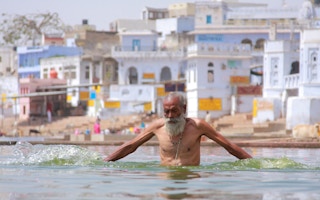More Indian cities need to implement heat action plans that include text-message alerts and cooling stations, to minimise deaths and illnesses related to rising temperatures, climate change experts and human rights activists said on Friday.
At least 36 people have died from a heatwave this year, with the nation’s capital Delhi recording its highest-ever temperature of 48 degrees Celsius (118 Fahrenheit), and temperatures in Churu in Rajasthan state hitting 51C.
Cities experience higher temperatures because paved surfaces and the lack of tree cover cause “urban heat islands”, said Sayantan Sarkar, who helped implement India’s first Heat Action Plan (HAP) in Ahmedabad in 2013.
“Cities bear the brunt of a heatwave because they are so densely populated, and because the effects are more pronounced,” he told the Thomson Reuters Foundation.
“But not all cities have the capacity to implement the measures needed, and the lack of comprehensive medical records makes it harder to target vulnerable groups such as the homeless and migrant workers,” he said.
Heatwaves in India typically occur in the pre-monsoon period from April to June.
Ahmedabad implemented its HAP after a heatwave in 2010 caused more than 1,300 heat-related deaths.
“
Cities bear the brunt of a heatwave because they are so densely populated, and because the effects are more pronounced.
Sayantan Sarkar, co-author, Heat Action Plan (HAP)
The plan included an early warning system using electronic displays in public places and text messages, training medical personnel to recognise and respond to heat-related illnesses, and “cool roofs” that used reflective surfaces or coatings to reduce temperatures in low-income and informal housing.
Since its launch, the HAP has helped prevented about 1,100 deaths each year in Ahmedabad, according to a study published in the Journal of Environmental and Public Health last year.
India’s National Disaster Management Authority (NDMA) issued guidelines in 2016 for heat action plans based on the Ahmedabad plan. They have since been adopted in more than a dozen states, said Arup Kumar Srivastava, a heatwave expert at NDMA.
“The casualties would be much higher were it not for the heat action plans that many cities have adopted,” he said.
“This year, night-time temperatures have also remained high, which poses additional risks. So the plans need to be modified accordingly,” he said.
A critical feature of Ahmedabad’s HAP is checking on vulnerable populations including the homeless and slum dwellers.
This is particularly relevant in cities such as Delhi, which has one of the largest homeless populations in the country, said Shivani Chaudhry, executive director of advocacy group Housing and Land Rights Network (HLRN).
At least six homeless people probably died from the heat every day from May 1 to June 10 this year in Delhi, with several more deaths going unreported, according to HLRN.
“Homeless persons are most vulnerable to the heat, as the majority live outdoors and do not have access to adequate shelter, drinking water and healthcare,” said Chaudhry.
“The city has a winter plan for the homeless, which includes setting up temporary tents, but there is no similar effort in the summer - even though they suffer as much, if not more in the severe heat,” she said.
Delhi government officials said in April they are preparing an action plan to minimise the impact of extreme weather conditions including heatwaves, which will be ready in 2020.
This story was published with permission from Thomson Reuters Foundation, the charitable arm of Thomson Reuters, that covers humanitarian news, climate change, resilience, women’s rights, trafficking and property rights. Visit http://news.trust.org/climate.

















